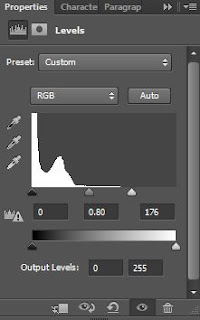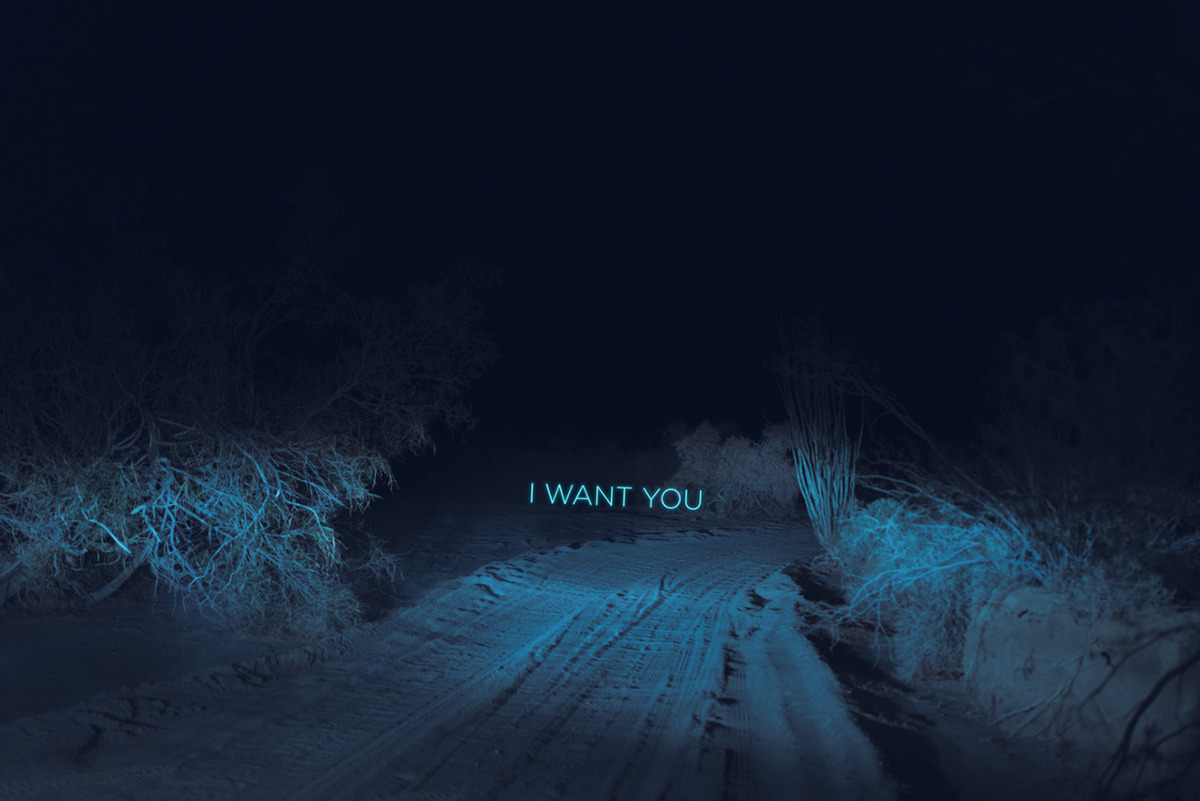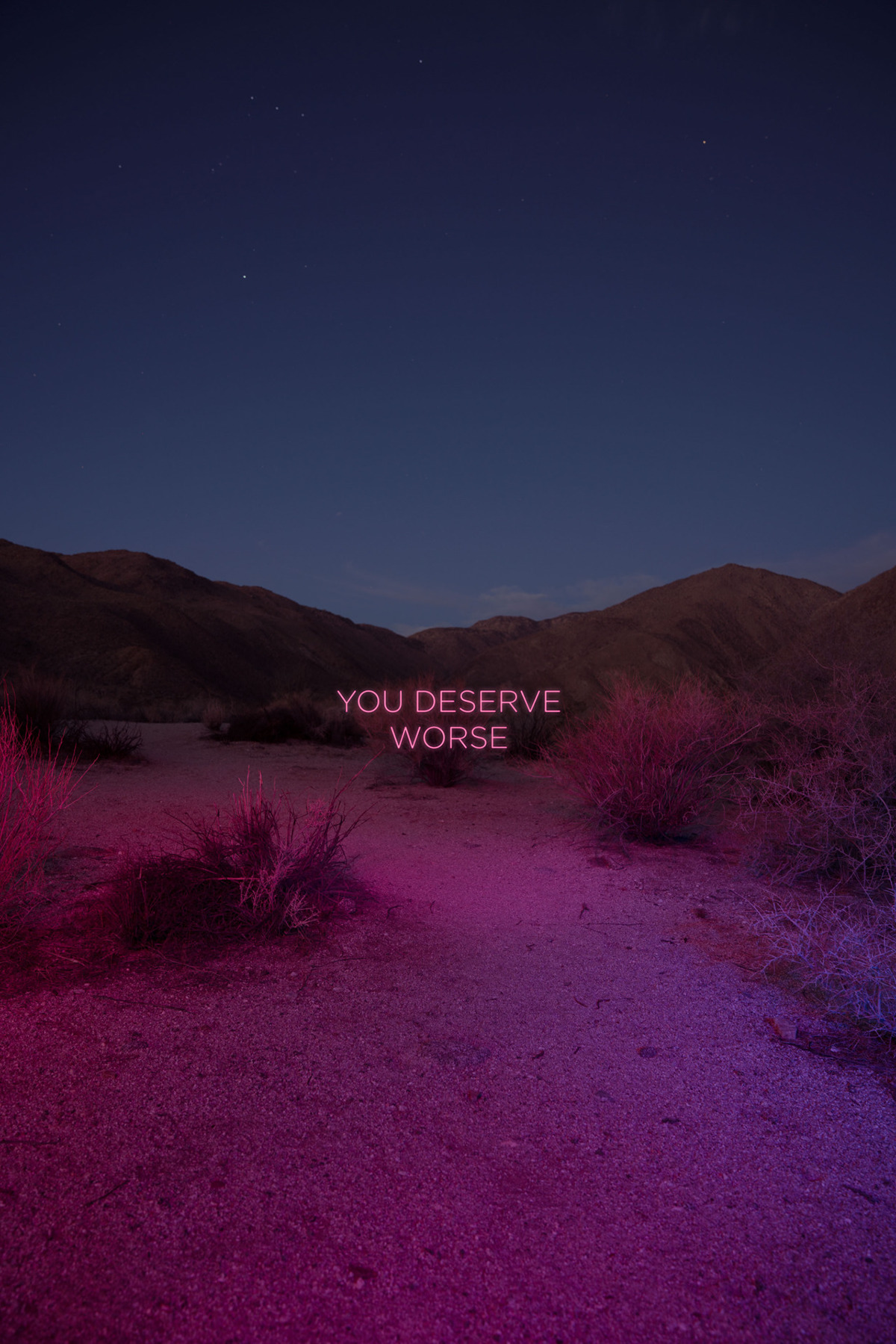In this shoot, I will be looking into artificial light photography that involves more colour and heavier editing processes. This is to develop my photo editing skills and vary my compositions in artificial lighting for my final photos. I will be looking into a photographer who captures colourful artificial light and uses a more intense editing process to influence my work. This influence will help me to create a shoot that presents a more colourful portfolio.
Research
Victoria Siemer
Victoria Siemer is a Brooklyn-based American graphic artist who focuses mainly on photo manipulation using Photoshop. She goes by the moniker "Witchoria" because "digital manipulation has given me the ability to create my own alternate realities where anything is possible. Sometimes it feels like magic." Her personal portfolio 'Hue Don't Own Me' is an exploration of 'emotion + light + colour'. She used gelled lights to create the landscapes and added the text in Photoshop. I did further analysis into Siemer's work on the blog post 'Photographer Research - Victoria Siemer'.
Image bank
Contact sheet
These are all the photos I took for this shoot.
These are all the photos I took for this shoot.
Best Photos
These are my best-selected photos from the shoot.
Photos that require improvement
These are two photos that I believe required improvement, this mainly being due to the grainy appearance. The first photos exposure settings were shutter speed 1/640sec and aperture F5.6, which was a lower exposure compared to the other photos, explaining why it appeared less vibrant. I later improved this photo by bringing the shutter speed up to 1/250sec and aperture to F5. The second photo does have these exposure settings, however, the deep blue hue appeared to make the photo too dim and grainy. The only way to improve this was to use a lighter tone of blue in the photos.
AO3: Record ideas, observations and insights relevant to intentions,
reflecting critically on work and progress.
My Ideas
My intention for this shoot was to experiment and use aspects of colourful artificial light in more work and use the influence of the photographer Victoria Siemer. I intended to keep to the incorporation of portraiture in this experimentation. However, I feel this shoot was not successful due to the light setting I created. I do not yet have gels to use like Siemer uses, so I was limited to where the colour could be captured and the brightness of the colour due to using a colour-changing light bulb on my ceiling. This made the photos grainy and impossible to get a sensitive enough exposure to make the photo bright enough. So, I will be taking another shoot when I have gels to use.
Reference to best photos
I selected this photo as one of the best because of its mischievous and sinister setting. The deep red creates an atmosphere of something dangerous or evil; this combined with the pose that appears as though I am scheming something, conveys an evil character with an evil backstory.
I selected this photo because of its icy and miserable atmosphere. The cold blue creates a forlorn atmosphere and a sense of crying to the viewer. This hue combined with the pose of me holding my face and my shoulders tensed up conveys as though my tears has created this icy blue light.
I selected this photo because of its vibrant and careless mood. The yellow tone adds a cheery and calming atmosphere to the photo and including my careless and relaxed pose furthers this atmosphere.
AO2: Explore and select appropriate resources, media, materials, techniques
and processes, reviewing and refining ideas as work develops.
Shoot Process/Use of Camera
For this shoot, I used a colour-changing light bulb attached to my ceiling to the left of me, and stood my Nikon D3400 camera on a tripod and used a self-timer setting on my camera to capture myself. The camera settings were shutter speed 1/250sec, aperture F5, and exposure at ISO25600. I would put a subject in my place while setting up the focal length and making sure the lens was focused in the right field, then I'd set the self-timer, remove the subject and take its place to then pose in various ways on each capture.
Experimenting
Since Siemer's work presents vivid colours, I used photoshop to attempt to restore some appearance in these photos.
Since Siemer's work presents vivid colours, I used photoshop to attempt to restore some appearance in these photos.
Firstly, I pressed CTRL+J to copy the original photo layer so I could go back to it if I made any mistakes.
Secondly, I added an adjustment layer of 'levels', and increased the white tones in the photo and slightly lowered the mid-tones in the photo. This created a more vivid colour appearance and made the shadows in the photo sharper.
This is the before and after effect of the edit.
These are all the layers used.
AO1: Develop ideas through sustained and focused investigations informed by
contextual and other sources, demonstrating analytical and critical
understanding.
Through my research, I was able to discover the use of gels and discover a new photoshop technique from Siemer's work. Unfortunately, I was unable to use practice either of these, but in the next shoot, I will be practicing this. Siemer's work has inspired me to focus on colourful artificial light for the rest of my work and experiment with more extreme editing processes.
AO4: Present a personal and meaningful response that realises intentions and,
where appropriate, makes connections between visual and other elements.
Progression
Overall, I would say this shoot was unsuccessful due to the materials I was reduced to using, leaving the photos to be grainy and under-exposed. I find Siemer's work to be enticing with its vibrant colours and cryptic, forlorn messages. She uses artificial light in a vivid and emotional way, while also using skilful edit processes, I find inspiration from this and plan to do the same with my work moving forward. For my next shoot, I will be using gels, just like Siemer does, and plan to use heavier editing processes.
































































